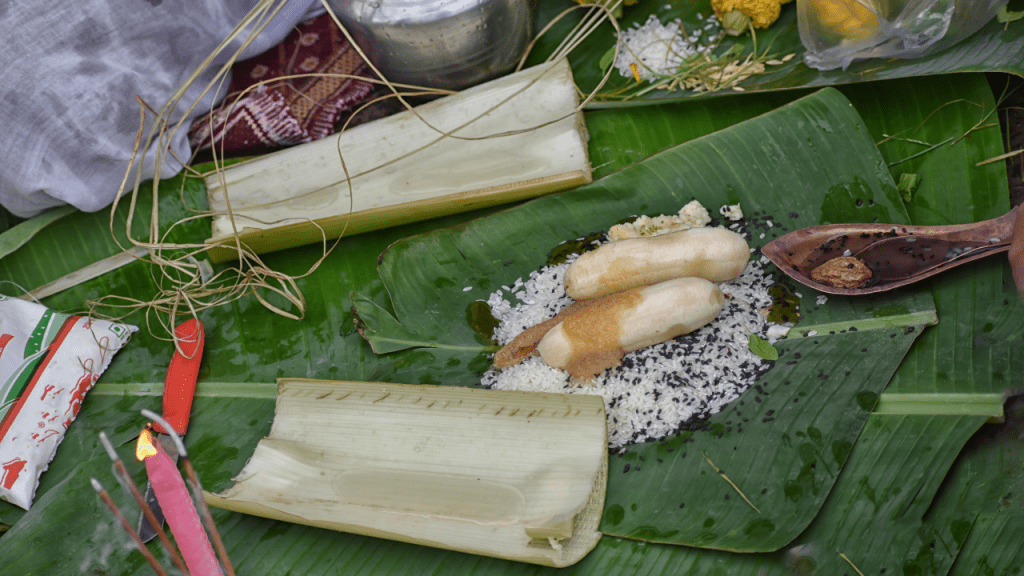Buddha famously said that ‘Life is Suffering’. Many realists quote this aphorism from Buddha to depict the condition of life for the vast majority of humanity. However nobody sufficiently quotes the next statement Buddha made: There is a way out of suffering.
Like Buddha, Indian Yogis and Siddhas have always maintained that misery need not be the ultimate destiny of man. However it is important to understand the causes of misery before we can do anything to neutralise it. One of the most important causes behind personal misery – as identified by Yogis and Siddhas – is Ancestral Karma – our dysfunctional (and functional) energy legacy from our deceased ancestors.
In some religions, all circumstances of life – good or bad – are attributed to personal karma. However, Hinduism refrains from such an oversimplification and has a more nuanced approach towards the vagaries of life. Hinduism claims that what a human being goes through sometimes has its origins in sources beyond what he or she has personally thought, spoken or done in the past. That is to say that besides personal karma, Hinduism also believes in other Karmic sources – one of which is Ancestral Karma.

ANCESTRAL KARMA AND ANCESTRAL HEALING
Just the way we inherit physical genes from our elders, we also inherit energy genes at the level of our soul. My master Dr. Baskaran Pillai calls this science ‘Soul Genetics’. So in essence, Ancestral Karma implies the descendants living out the attitudes, inclinations, habits, trauma, life struggles, strengths and breakthroughs of one’s maternal and paternal ancestors who walked the Earth plane before one.
As the book ‘It didn’t start with you’ by Mark Wolynn implies, the roots of anxiety, depression, chronic pain, phobias and obsessive thoughts may not reside in our immediate life experience or in chemical imbalances in our brains—but in the lives of our parents, grandparents, and even great-grandparents.
According to epigenetics experts, holocaust survivors are known to carry a biological marker in their chromosomes which makes their future generations more susceptible to depression, anxiety and nightmares as compared to those not descended from Holocaust survivors.
Ancestral Healing therefore involves healing ancestral karma a.k.a. intergenerational karma i.e. neutralising the dysfunctional thought and behaviour patterns and harnessing the functional thought and behaviour patterns of our ancestors. These patterns happen to be deeply embedded in our own inner climates and are always playing themselves out in our lives in some or the other ways.
Some of us in the family tree have to ‘break the chain’ of these dysfunctional patterns from our bloodline in order to heal our ancestors as well as heal ourselves, our families and our progenies.

CAN’T THE ANCESTORS HELP THEMSELVES?
Religions like Hinduism (and many more) that subscribe to life after death state that a soul has an after-life beyond its journey on the Earth realm. During this after-life a soul continues its journey in the astral realms without necessarily taking rebirth immediately. Dolores Cannon in her book ‘Between Life and Death’, has shared conversations from her past life therapy sessions where souls have often clarified that they do not have to take birth immediately after their death, that they have to play out the results of their seed-actions in non-material realms before they can come back to Earth to further live out their karmic cycles and take forward their learning cycles. Every soul has a different karmic blueprint and hence their timelines upto rebirth are different too. Until then, these souls (in the current context – our ancestors) are often living in a disembodied condition.
Not having a body means that the ancestors are busy playing out their karma but have no agency or free will in doing anything to resolve their karma i.e. they cant reverse or mitigate the painful results of the thoughts and deeds from their own past or from their personal ancestors. In such a scenario, they are dependent upon their living progeny – who have the gift of an active free will – on the Earth plane to help them mitigate the effects of negative karma. After all, they can look only to the able people they know for help.
On the other hand, it becomes the duty of the living progeny to help their disembodied ancestors out by helping them heal their dysfunctional energies. Some scriptures also openly state that ancestors when not helped by their living progeny (on particular days when the ancestors are most expectant of healing energies) place a curse upon their progeny out of wrath. This looks unloving and unlikely to our rose-tinted spiritual selves but could well be a real possibility. After all, these ancestors though disembodied are most human in their wiring. Don’t we as humans feel hurt and betrayed and call names when our near and dear ones who are obligated to us act selfish and can’t hold space for us in return or don’t support us enough when we are hurting? Ditto with the disappointed ancestors.
On the other hand, on the occasion of receiving help, the same ancestors happily move on to less troublesome and more pleasurable higher astral planes and abundantly bless the descendants in return.

SCIENCE OF ANCESTRAL HEALING
Ancestral healing modalities sometimes take the form of a set of spiritual rituals that helps one connect and nurture relationships with their ancestors and healing one’s own heart. This is done by not only understanding the genesis of certain behaviour patterns that have percolated down to one from way up but healing is also experienced by feeling a sense of strong belonging to one’s soul group which is so much larger than one’s little troubled self. Healing is also experienced through the very process of reconnecting to one’s roots and genetic and soul group heritage. This also often helps one to perceive one’s own troublesome dispositions as family-sourced and hence find acceptance and forgiveness towards self and in turn towards others. In many cases, consistent ancestral healing work also affords a deepening clarity about one’s life purpose.
Besides personal and ancestral karma, there is a third (and last) dimension of karma that is often not accounted for: collective karma. This is the collective trauma as carried by soul groups relating to race, gender, religion, war and similar collective dimensions. Because ancestors by default carry this collective karma, doing ancestral healing work also helps a person shed some of his or her own painful collective karma which changes one’s attitudes and thought-processes for the better. All this work also draws upon blessings from spiritually vibrant ancestors for success in one’s vocation and prosperity, including tangible support and direction in daily life.

ANCESTRAL MEDICINE EXISTS ACROSS CULTURES
Ancestral Healing – also called Ancestral Medicine – is practised across the world in multiple forms. Besides its presence in many of the organised religions of the world, this modality has existed in ancient pagan and shamanic religions for eons.
Different cultures have their own unique ways to address ancestral distress. Shamanic religions had shamanic processes like ancestral healing circles and ancestral release rituals to invoke and connect to what they call the ‘heritage of one’s bloodline’.
Muslims have a festival called ‘Shab E’ Baraat’ – which occurs 15 days before the advent of Ramzan – in which they light up the graveyards of the deceased once a year. These visits are prescribed in Islam for the purpose of ‘making duaa for the dead, praying for mercy for them, remembering death and preparing oneself for the Hereafter’.
All Abrahamic religions (Judaism, Christianity and Islam) have the concept of conducting memorials on graveyards for the deceased. Pitru Tarpan or Shraaddh is the name of the ritual prescribed in the Hindu religion to liberate one’s ancestors.
TARPAN: THE MOST QUICK AND EFFECTIVE ANCESTRAL HEALING MODALITY
Tarpan is a Sanskrit word which in Vedic practice means offerings made to a divine entity. Tilatarpan is another related term which means libations offered to deceased ancestors or pitrus using sesame seeds and water during the death rites or during astrologically significant special windows of power times for ancestral healing. This special mixture is offered by the male of the family during the first Shraaddh or any subsequent shraaddhs or on other power days such as new moon days and eclipses or during pilgrimage to holy sites.
Pitru paksha or Shraadh is the time in the Hindu calendar (1st to 15th phase of the moon of the Hindu month of Ashwin) where people offer and seek blessings from dead ancestors. During this period, people usually perform the tarpan rituals with the help of a priest to pay respect to their ancestors. These rituals are performed to relieve the souls of the ancestors so they can get liberation. This ritual is specially performed by people who have been astrologically detected to carry ancestors’ curses or pitrudosh in their personal charts. Ideally, one must perform the Tarpan everyday throughout the 15 days of pitru paksha, but the rituals performed on the last day i.e. the Mahalaya Amavasya are the most important ones.
It is believed that ancestors wait for Tarpan on all of the above days. If this is not offered to the ancestors they return to their realm with disappointment. And their descendants might not just miss out on their blessings but also incur wrath from them as we discussed earlier.
My Guru Dr. Baskaran Pillai suggests that one should ideally perform Tarpan daily either on one’s own or through a competent priest or both. He unequivocally states that Tarpan is one such powerful ritual which is way more important than any other ritual for the sake of rewriting one’s destiny.

HOW TO DO TARPAN AT HOME?
In India, Haridwar, Varanasi, Allahabad, Ujjain, Mathura, Pushkar, Gaya, Rameshwaram and parts of Kerala are some of the popular power spots one visits to hire trained priests to perform these rituals for the departed in the family.
Many people offer cooked food as Tarpan during the pitru paksha to feed the souls of the departed ancestors. There is a common belief in Hindu culture that if black ravens or crows feed from this plate of offered food, it is an omen signifying that the food has reached the souls of the departed ancestors.
However, you don’t necessarily need to go to a power spot or hire a priest or offer cooked food to perform the basic ritual of tarpan. You can do Tarpan by yourself by putting together these ingredients:
- Sesame Seeds
- Darbha Grass
- Rice Flour or Rice Grains
- A Currency Coin
- A Spoonful of Water
One is to collect these ingredients in one’s right palm and call upon six generations of departed ancestors from one’s mother’s side. Ancestors immediately show up astrally in response to this call. Then with all the love, offer them the ingredients in your right palm asking them to receive these energies, be healed, be at peace, cross into the light and bless you in return. After the same, wash off your hand and ingredients with water. You can reuse the coin and dispose off the other ingredients. Repeat the same process for six generations of departed ancestors from your father’s side. And that’s it.

FAQ’S AROUND TARPAN
Is this Tarpan process over-simplified?
Can women offer Tarpan to their ancestors?
What time of the day does one perform Tarpan?
Can one perform Tarpan even if one’s father is alive?
Is there any particular direction one faces while doing Tarpan?
Can one do Tarpan more often than once a day?
Where does one dispose off the ingredients?
Can one offer Tarpan to other deceased who are not from one’s own bloodline?
HEALING THE LIVING
Our souls are connected with those of our ancestors in ways beyond our mortal understanding, The process of tarpan is to honour this very connection to our ancestor’s souls and make sure we help them move on to better realms through an act of kindness on our part. Besides, everyone in the living family line (and future progeny) gets to experience the most incredible healing benefits of performing Tarpan.
Can there be a better service to yourself, your ancestors, your current families and your future progeny than committing to this simple daily ritual that takes only two minutes to perform and yet often – as my master says – yields results greater than two hours of meditation?
